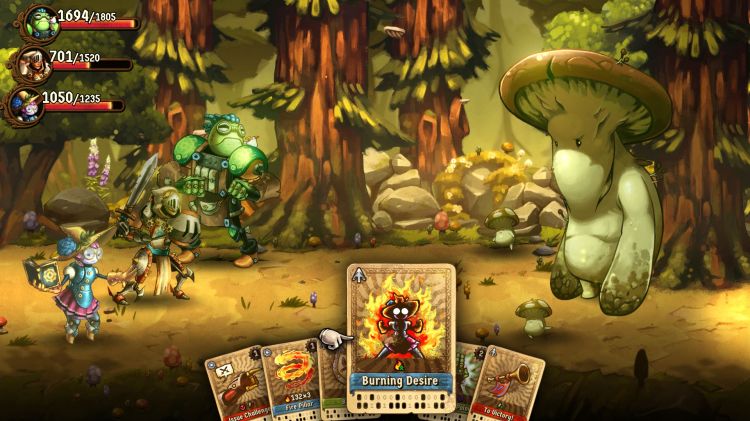I worried about SteamWorld Quest: Hand of Gilgamech. After falling in love with SteamWorld Dig 2 and SteamWorld Heist, I wasn’t sure that developer Image & Form Games could win me over in yet another genre. Where Dig is a Metroidvania and Heist is a tactics game, Quest is a role-playing adventure with card-based combat. So while all have the same art style and star sentient, steam-powered robots, they all play very differently. And different is scary — especially when familiar means a masterpiece like SteamWorld Dig 2.
Check out our Reviews Vault for past game reviews.
SteamWorld Quest is $25 on Nintendo Switch. It debuts April 25. And I think it is an excellent addition to the SteamWorld canon. It also proves that Image & Form is one of the most consistently great developers making games today.
What you’ll like
Excellent combat
In SteamWorld Quest you control a crew of wannabe adventurers. That means you’re going to end up in a lot of turn-based battles with monsters and scoundrels. And it’s in these fights — as well as preparing for them — that Quest is at its strongest.
In these battles, you control up to three heroes. But you do not have direct control over any of them. Instead, each of those characters has their own dedicated deck of eight cards. You draw a hand of seven cards from that pool, and that enables your various actions.
After some time with Quest, I get why card-based combat is so popular among designers. Where you may find yourself spamming the same button press over and over in menu-driven combat because you just want to attack, you don’t have that option here. I found myself using buffs and debuffs and other non-attack options frequently because they were in my hand. And Image & Form adds a lot of systems on top of the basics to keep you engaged in every fight.
Chain attacks
One of the key ways that the studio makes every card feel useful is through chain attacks. Your characters do not take turns. Instead, you can play any three cards from any combination of heroes. But if you are able to play three cards from one character on the same turn, you summon a special fourth card determined by your weapon. This gives you an ongoing meta goal beyond simply defeating the enemy.
You cannot simply drop three cards whenever you want because some cards generate cogs and other cards spend cogs. A powerful attack is likely going to require 1-to-3 cogs. I found myself wanting to use a buff card because it generated cogs, and that enabled me to play something more damaging.
This is so effective because it puts you in situations where you are creating synergies between cards and situations. Let’s say you have a card that cures status effects, a shield, and an attack for one character, but the attack requires 2 cogs. You’ll want to save those three cards for when one of your characters has a status effect and needs a shield. That way you are eliminating the ailment, protecting a vulnerable character, generating cogs, attacking an enemy, and playing three cards from one character all at the same time.
You are always looking for those situations, and it’s very satisfying when you make them work.
Character building
Between fights you’ll encounter some fun writing and a bit of exploration, but mostly you’ll just want to find more cards, equipment, and characters.
And developing your characters is fun. You can create decks that are generally effective against most enemies, or you can specialize them for specific needs. And you will have plenty of cards to craft at vendors if you need to shake things up.
I also like the equipment system. It’s basic with slots for a weapon, a set of armor, and an accessory, but that means it’s not overwhelming. You can still keep most of your brain working on how to build your decks, but then also still get some cool improvements for your character on the side.
What you won’t like
Exploration is rote
SteamWorld Quest’s map is just a series of rooms. The map indicates which door you came in from, and you need to find the door you haven’t gone through yet. And that’s about it. You’ll see some branching paths, but nothing too elaborate.
None of this is bad, but moving the heroes through the environment is often boring. And it’s nowhere near as engaging as the combat.
Conclusion
I really liked turn-based, menu-driven combat systems at one point. Super Mario RPG and Star Wars: Knights of the Old Republic were great. But these days, I can feel my attention drifting away when I play something like that.
SteamWorld Quest is so refreshing because it’s a turn-based RPG I want to play specifically because of its combat. It is so rewarding to work toward a big play and then drop three cards with multiple synergies.
I never should have doubted Image & Form, and I hope the studio knows that my expectations are now sky high for whatever it does next.
Score: 85/100
SteamWorld Quest: Hand of Gilgamech is out April 25 for $25. Image & Form Games provided a download code to GamesBeat for the purpose of this review.

